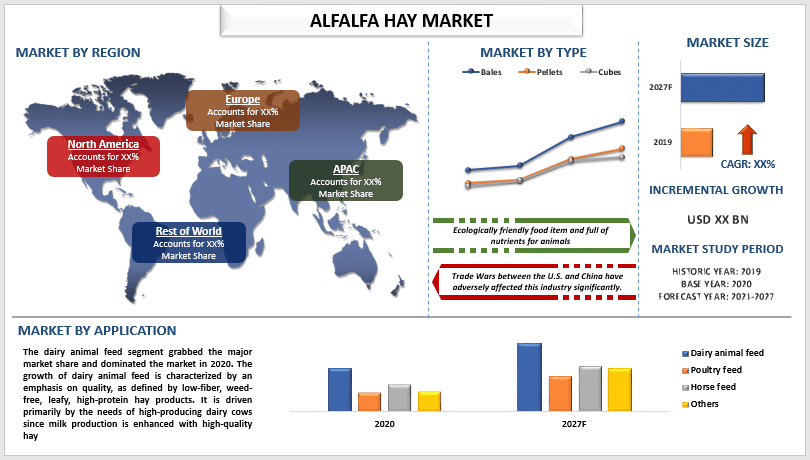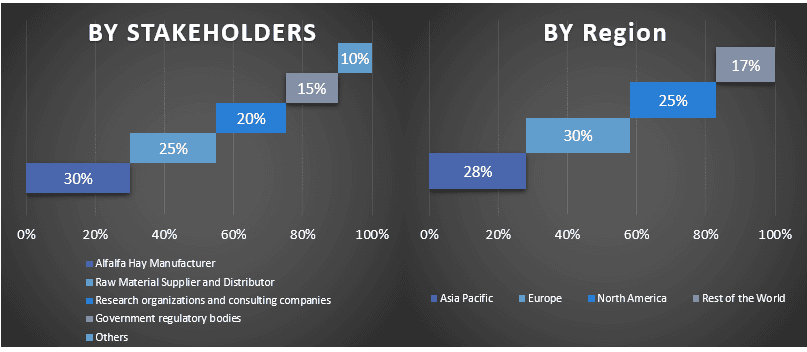- Startseite
- Über uns
- Industrie
- Dienstleistungen
- Lesen
- Kontaktieren Sie uns
Alfalfaheu-Markt: Aktuelle Analyse und Prognose (2021-2027)
Schwerpunkt auf Typ (Ballen, Paletten, Würfel); Anwendung (Milchviehfutter, Geflügelfutter, Pferdefutter, Sonstige); Endverwendung (Geflügel, Rinder, Vieh, Sonstige); und Region/Land

Die steigende Nachfrage nach Milch- und Tierprodukten, die Schrumpfung des Landes für Weidetiere, das Wachstum von Hochleistungsvieh sind einige der wichtigsten Faktoren, die den Markt für Alfalfa-Heu antreiben. Eine der wichtigsten Eigenschaften von Alfalfa ist seine hohe Nährstoffqualität als Tierfutter. Alfalfa produziert mehr Protein pro Hektar als jede andere Kulturpflanze. Alfalfa-Heu enthält 15-22 % Rohprotein und ist auch eine ausgezeichnete Quelle für Vitamine und Mineralien. Alfalfa enthält insbesondere die Vitamine A, D, E, K, U, C, B1, B2, B6, B12, Niacin, Pantothensäure, Inosit, Biotin und Folsäure.
Faktoren wie die geringe Verfügbarkeit von Substituten, Budgetfreundlichkeit, lange Haltbarkeit und der aufstrebende E-Commerce-Sektor sind einige der wichtigsten Faktoren, die zum Marktwachstum beitragen. Laut OEC wuchsen die Exporte von Saatgut, Luzerne (Alfalfa), zur Aussaat zwischen 2019 und 2020 um 13,4 % von 253 Mio. US$ auf 286 Mio. US$. Der Handel mit Saatgut, Luzerne (Alfalfa), zur Aussaat macht 0,0017 % des gesamten Welthandels aus. Darüber hinaus konzentrieren sich Unternehmen auf der ganzen Welt stärker auf strategische Allianzen, was zum Marktwachstum beiträgt. Zum Beispiel: Anderson Hay & Grain Inc. ist ein Joint Venture mit der Agitha Group, dem Marktführer für Tierfutter in den VAE, eingegangen. Das Joint Venture wurde mit dem Ziel gegründet, die Verbraucher in den VAE und im GCC besser zu bedienen.
Es wird erwartet, dass der globale Alfalfa Hay-Markt im Zeitraum von 2021 bis 2027 eine CAGR von rund 6 % verzeichnen wird. Heu ist die 3.rd grösste US-amerikanische Kulturpflanze in Bezug auf die Erntefläche. Es bietet auch Umweltdienstleistungen, insbesondere Erosionsschutz. Laut USDA wird die Produktion von Alfalfa und Alfalfa-Mischung Trockenheu für 2021 auf 48,2 Millionen Tonnen prognostiziert, 1 Prozent mehr als die Augustprognose, aber 9 % weniger als 2020. Im Jahr 2019 sind einige der Alfalfa-Heu produzierenden Staaten in den Vereinigten Staaten Kalifornien mit 7.060 Tausend Tonnen, Idaho mit 5.111 Tausend Tonnen und Minnesota mit 2.966 Tausend Tonnen. Diese Staaten machen fast 27,0 % der Alfalfa-Heuproduktion des Landes aus. Laut der University of California werden 61 % des gesamten auf den internationalen Märkten verkauften Heus in den Vereinigten Staaten ausgesät, angebaut und geschwadet. Der Gesamtwert der US-amerikanischen Alfalfa-Heuexporte ist ebenfalls stetig von rund 600 Millionen US-Dollar im Jahr 2014 auf etwas mehr als 1 Milliarde US-Dollar im Jahr 2021 gestiegen.
Al Dahra ACX Global Inc., Alfalfa Monegros SL, Anderson Hay & Grain Inc., Bailey Farms, Border Valley, Standlee Premium Products, LLC, Cubeit Hay Company, Glenvar Hay, Green Prairie International und Grupo Osés usw. sind einige der wichtigsten Akteure auf dem Markt. Mehrere Fusionen und Übernahmen sowie Partnerschaften wurden von diesen Akteuren eingegangen, um Kunden mit High-Tech- und innovativen Produkten/Technologien zu versorgen.
Im Bericht dargestellte Erkenntnisse
"Unter den Anwendungen machte die Kategorie Tierfutter für Milchtiere im Jahr 2020 den grössten Anteil am Markt aus"
Basierend auf der Anwendung ist der Markt in Tierfutter für Milchtiere, Geflügelfutter, Pferdefutter und andere unterteilt. Das Segment Tierfutter für Milchtiere eroberte einen beträchtlichen Marktanteil und erzielte im Jahr 2020 USD XX Mio. Die wachsende Zahl von Milchvieh wie Rindern, Ziegen usw. und die Abnahme der Weidefläche führen zu einer steigenden Nachfrage nach Alfalfa-Heu aus diesem Segment. Im Jahr 2015 gab es 969,2 Millionen Rinder, die bis 2021 auf 996,1 anstiegen.
"Unter den Würfeln wird erwartet, dass das Segment der Würfel im Prognosezeitraum die höchste CAGR aufweisen wird"
Basierend auf der Art ist der Markt in Ballen, Paletten und Würfel unterteilt. Das Alfalfa-Segment der Würfel eroberte den grössten Marktanteil aufgrund des Vorteils gegenüber Ballen, da Ballen schwer, unordentlich und umständlich sind. Bis zu 20 % des konventionellen Heus können bei der Fütterung verschwendet werden. Die Vorteile wie kontrollierte Futteraufnahme, weniger Staub als langstieliges Heu, geringere Lageranforderungen, einfache Handhabung und reduzierte Transportkosten wirken als Wachstumstreiber für die Branche.
"Nordamerika wird im Prognosezeitraum ein deutliches Wachstum verzeichnen"
Für ein besseres Verständnis der Marktakzeptanz des Alfalfa Hay-Marktes wird der Markt basierend auf seiner weltweiten Präsenz in den Ländern wie Nordamerika (die Vereinigten Staaten, Kanada, der Rest Nordamerikas), Europa (Deutschland, Frankreich, Italien, Spanien, das Vereinigte Königreich und der Rest Europas), dem asiatisch-pazifischen Raum (China, Japan, Indien, Australien und der Rest des asiatisch-pazifischen Raums) und dem Rest der Welt analysiert. Die Region Nordamerika eroberte im Jahr 2020 den grössten Markt für die Alfalfa Hay Market-Industrie. Die Region Europa wird jedoch in den kommenden Jahren eine beträchtliche CAGR verzeichnen.
Gründe für den Kauf dieses Berichts:
- Die Studie umfasst eine Marktdimensionierungs- und Prognoseanalyse, die von authentifizierten wichtigen Branchenexperten validiert wurde.
- Der Bericht bietet einen schnellen Überblick über die Gesamtleistung der Branche auf einen Blick.
- Der Bericht behandelt eine eingehende Analyse prominenter Branchenkollegen mit einem primären Fokus auf wichtige Finanzkennzahlen, Produktportfolios, Expansionsstrategien und aktuelle Entwicklungen.
- Detaillierte Untersuchung von Treibern, Hemmnissen, wichtigen Trends und Chancen, die in der Branche vorherrschen.
- Die Studie deckt den Markt umfassend über verschiedene Segmente hinweg ab.
- Tiefgreifende regionale Analyse der Branche.
Anpassungsoptionen:
Der globale Alfalfa Hay-Markt kann weiter an die Anforderungen oder jedes andere Marktsegment angepasst werden. Darüber hinaus versteht UMI, dass Sie möglicherweise Ihre eigenen geschäftlichen Anforderungen haben. Nehmen Sie daher gerne Kontakt mit uns auf, um einen Bericht zu erhalten, der Ihren Anforderungen vollständig entspricht.
Inhaltsverzeichnis
Forschungs-Methodik für die Globale Alfalfa Hay Markt Analyse (2021-2027)
Die Analyse des historischen Marktes, die Schätzung des aktuellen Marktes und die Prognose des zukünftigen Marktes des globalen Alfalfa Hay Marktes waren die drei wichtigsten Schritte, die unternommen wurden, um die Akzeptanz von Alfalfa Hay in wichtigen Regionen weltweit zu schaffen und zu analysieren. Umfassende Sekundärforschung wurde durchgeführt, um die historischen Marktzahlen zu sammeln und die aktuelle Marktgröße zu schätzen. Zweitens wurden zahlreiche Erkenntnisse und Annahmen berücksichtigt, um diese Erkenntnisse zu validieren. Darüber hinaus wurden umfangreiche Primärinterviews mit Branchenexperten entlang der Wertschöpfungskette des globalen Alfalfa Hay Marktes geführt. Nach Annahme und Validierung der Marktzahlen durch Primärinterviews wendeten wir einen Top-Down/Bottom-Up-Ansatz an, um die vollständige Marktgröße zu prognostizieren. Danach wurden Marktaufschlüsselungs- und Datentriangulationsmethoden angewendet, um die Marktgröße von Segmenten und Untersegmenten der Branche zu schätzen und zu analysieren. Die detaillierte Methodik wird im Folgenden erläutert:
Analyse der historischen Marktgröße
Schritt 1: Eingehende Studie von Sekundärquellen:
Eine detaillierte Sekundärstudie wurde durchgeführt, um die historische Marktgröße des Alfalfa Hay Marktes aus unternehmensinternen Quellen wie Jahresberichten & Finanzberichten, Performance-Präsentationen, Pressemitteilungen usw. und externen Quellen wie Fachzeitschriften, Nachrichten & Artikeln, Regierungsveröffentlichungen, Wettbewerberveröffentlichungen, Sektorberichten, Datenbanken von Drittanbietern und anderen glaubwürdigen Veröffentlichungen zu erhalten.
Schritt 2: Marktsegmentierung:
Nachdem wir die historische Marktgröße des Alfalfa Hay Marktes ermittelt hatten, führten wir eine detaillierte Sekundäranalyse durch, um historische Markteinblicke und Anteile für verschiedene Segmente & Untersegmente für wichtige Regionen zu sammeln. Zu den wichtigsten Segmenten, die in dem Bericht enthalten sind, gehören Anwendung, Typ und Endverbraucher. Darüber hinaus wurden Analysen auf Länderebene durchgeführt, um die allgemeine Akzeptanz von Alfalfa Hay in dieser Region zu bewerten.
Schritt 3: Faktorenanalyse:
Nachdem wir die historische Marktgröße verschiedener Segmente und Untersegmente ermittelt hatten, führten wir eine detaillierte Faktorenanalyse durch, um die aktuelle Marktgröße des Alfalfa Hay Marktes zu schätzen. Darüber hinaus führten wir eine Faktorenanalyse unter Verwendung von abhängigen und unabhängigen Variablen durch, wie z. B. die steigende Anzahl von Tieren, die für den Anbau und die Produktion gehalten werden, die Erschwinglichkeit und die längere Haltbarkeit usw. Eine gründliche Analyse wurde für Nachfrage- und Angebotsseitenszenarien unter Berücksichtigung von Top-Partnerschaften, Fusionen und Übernahmen, Geschäftsausweitungen und Produkteinführungen im Alfalfa Hay Marktsektor auf der ganzen Welt durchgeführt.
Schätzung & Prognose der aktuellen Marktgröße
Aktuelle Marktgröße: Basierend auf den umsetzbaren Erkenntnissen aus den oben genannten 3 Schritten kamen wir zu der aktuellen Marktgröße, den wichtigsten Akteuren im globalen Alfalfa Hay Markt und den Marktanteilen der Segmente. Alle erforderlichen prozentualen Anteile und Marktaufschlüsselungen wurden unter Verwendung des oben genannten sekundären Ansatzes ermittelt und durch Primärinterviews verifiziert.
Schätzung & Prognose: Für die Marktschätzung und -prognose wurden verschiedene Faktoren wie Treiber & Trends, Beschränkungen und Chancen, die den Stakeholdern zur Verfügung stehen, gewichtet. Nach der Analyse dieser Faktoren wurden relevante Prognosetechniken, d. h. der Top-Down/Bottom-Up-Ansatz, angewendet, um die Marktprognose bis etwa 2027 für verschiedene Segmente und Untersegmente in den wichtigsten Märkten weltweit zu erstellen. Die Forschungsmethodik, die zur Schätzung der Marktgröße angewendet wird, umfasst:
- Die Marktgröße der Branche in Bezug auf den Umsatz (USD) und die Akzeptanzrate des Alfalfa Hay Marktes in den wichtigsten Märkten im Inland
- Alle prozentualen Anteile, Aufteilungen und Aufschlüsselungen von Marktsegmenten und Untersegmenten
- Die wichtigsten Akteure im globalen Alfalfa Hay Markt in Bezug auf die angebotenen Lösungen. Außerdem die Wachstumsstrategien, die diese Akteure anwenden, um in dem schnell wachsenden Markt zu konkurrieren
Validierung der Marktgröße und des Marktanteils
Primärforschung: Es wurden eingehende Interviews mit den Key Opinion Leaders (KOLs) geführt, darunter Top Level Executives (CXO/VPs, Sales Head, Marketing Head, Operational Head, Regional Head, Country Head, usw.) in den wichtigsten Regionen. Die Ergebnisse der Primärforschung wurden dann zusammengefasst und eine statistische Analyse durchgeführt, um die aufgestellte Hypothese zu beweisen. Die Erkenntnisse aus der Primärforschung wurden mit den Ergebnissen der Sekundärforschung zusammengeführt, wodurch Informationen in umsetzbare Erkenntnisse umgewandelt wurden.
Aufteilung der primären Teilnehmer in verschiedene Regionen

Market Engineering
Die Datentriangulationstechnik wurde angewendet, um die Gesamtmarktschätzung abzuschließen und genaue statistische Zahlen für jedes Segment und Untersegment des globalen Alfalfa Hay Marktes zu erhalten. Die Daten wurden in mehrere Segmente & Untersegmente aufgeteilt, nachdem verschiedene Parameter und Trends in den Bereichen Anwendung, Typ und Endverbraucher im globalen Alfalfa Hay Markt untersucht worden waren.
Das Hauptziel der Global Alfalfa Hay Marktstudie
Die aktuellen & zukünftigen Markttrends des globalen Alfalfa Hay Marktes wurden in der Studie genau bestimmt. Investoren können strategische Einblicke gewinnen, um ihre Entscheidungen für Investitionen auf der Grundlage der in der Studie durchgeführten qualitativen und quantitativen Analyse zu treffen. Aktuelle und zukünftige Markttrends bestimmten die Gesamtattraktivität des Marktes auf regionaler Ebene und boten den Industrieteilnehmern eine Plattform, um den unerschlossenen Markt zu nutzen und von einem First-Mover-Vorteil zu profitieren. Weitere quantitative Ziele der Studien sind:
- Analyse der aktuellen und prognostizierten Marktgröße des Alfalfa Hay Marktes in Bezug auf den Wert (USD). Außerdem Analyse der aktuellen und prognostizierten Marktgröße verschiedener Segmente und Untersegmente
- Die Segmente in der Studie umfassen die Bereiche Anwendung, Typ und Endverbraucher
- Definition und Analyse des regulatorischen Rahmens für die Alfalfa Hay Marktindustrie
- Analyse der Wertschöpfungskette mit der Beteiligung verschiedener Vermittler sowie Analyse des Kunden- und Wettbewerbsverhaltens der Branche.
- Analyse der aktuellen und prognostizierten Marktgröße des Alfalfa Hay Marktes für die Hauptregion.
- Zu den wichtigsten Ländern der in dem Bericht untersuchten Regionen gehören Asien-Pazifik, Europa, Nordamerika und der Rest der Welt.
- Unternehmensprofile des Alfalfa Hay Marktes und die Wachstumsstrategien, die von den Marktteilnehmern angewendet werden, um sich in dem schnell wachsenden Markt zu behaupten
- Tiefgehende regionale Analyse der Branche
Verwandt Berichte
Kunden, die diesen Artikel gekauft haben, kauften auch










